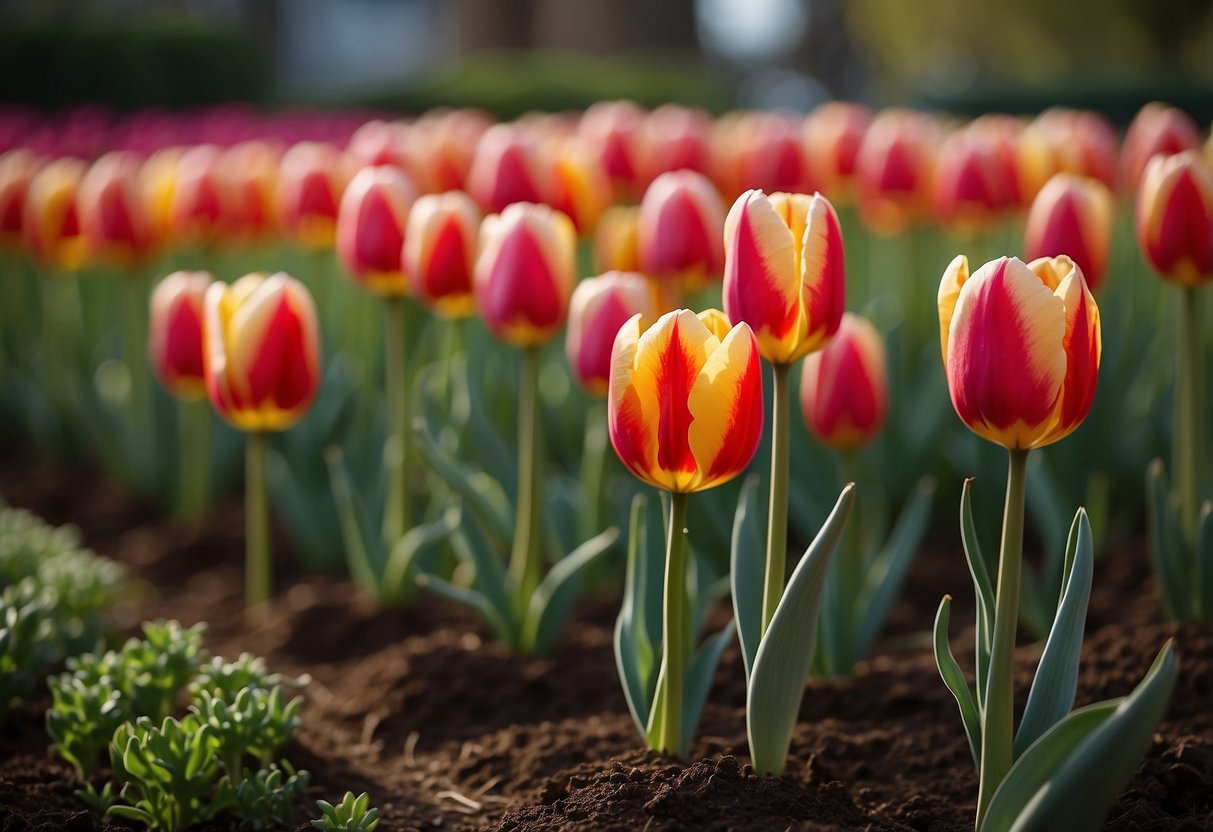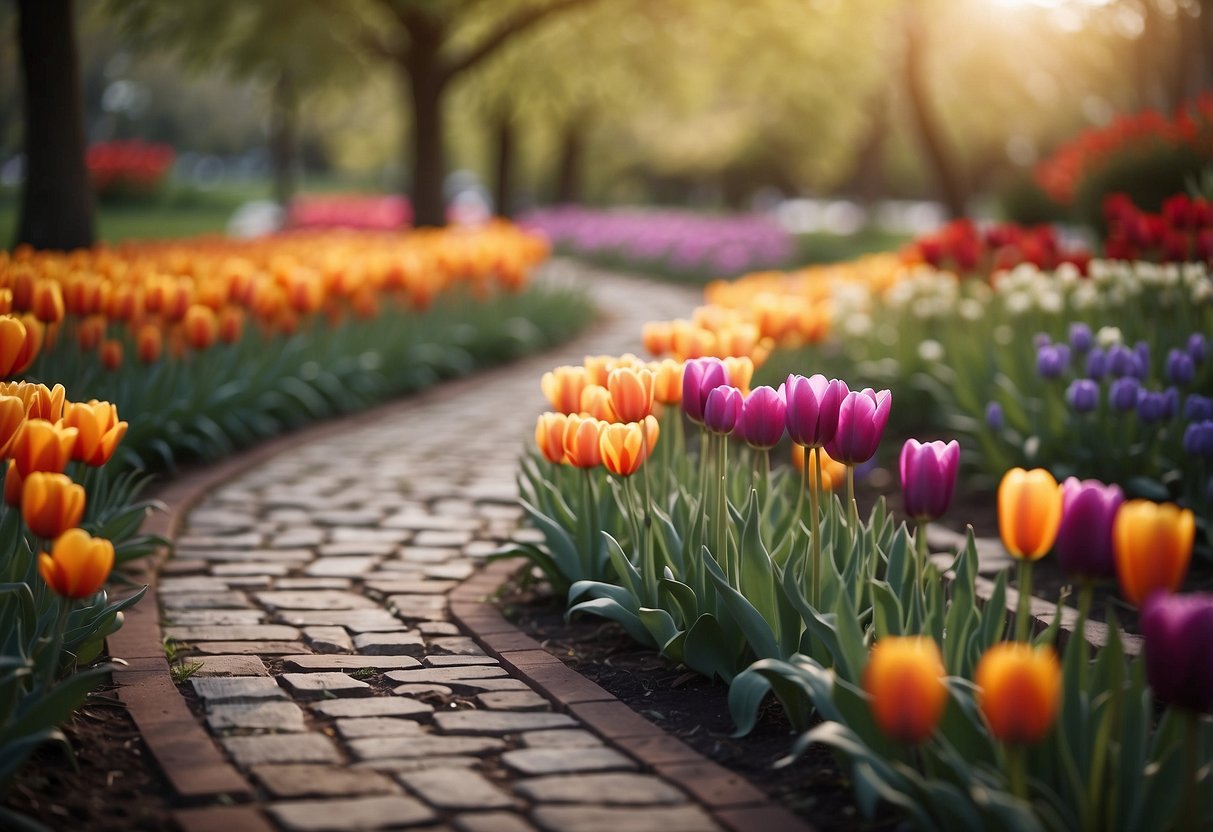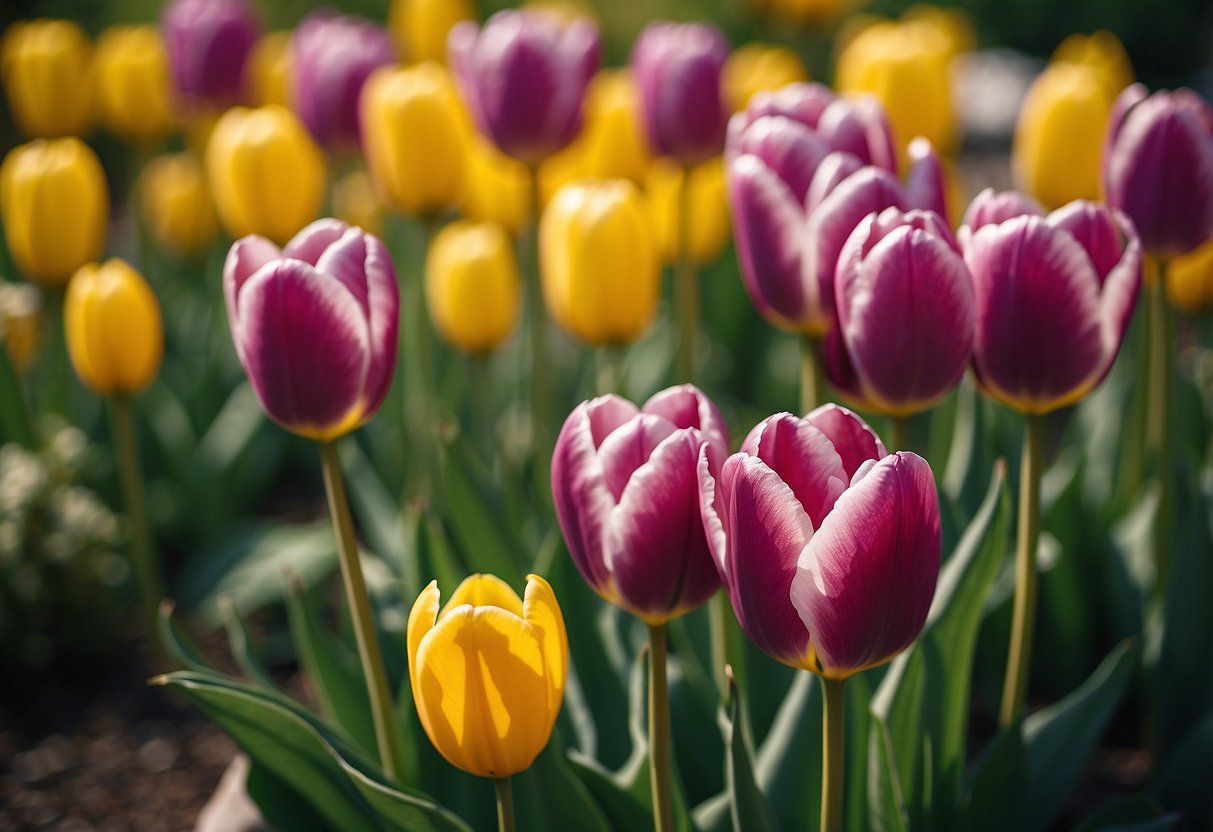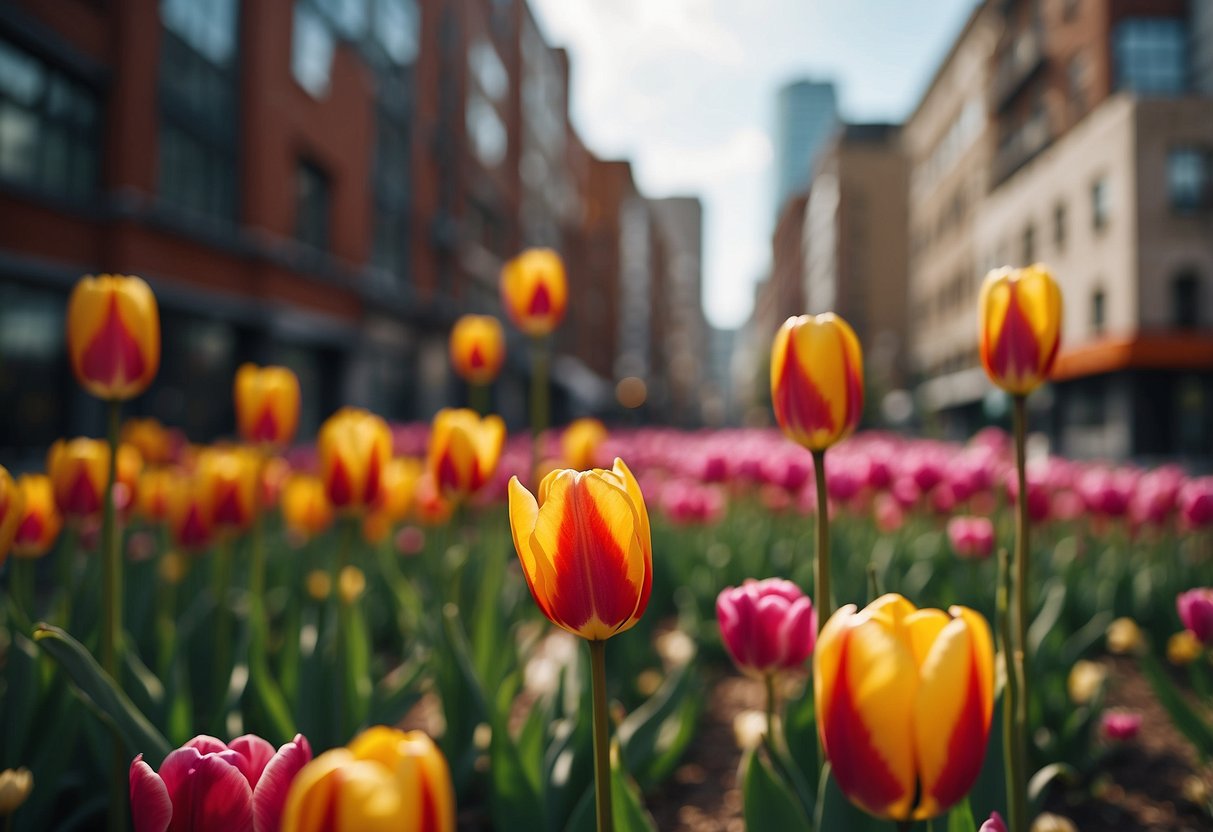Tulip Garden Ideas: Brighten Your Backyard with Colorful Blooms
Planning a tulip garden can be a delightful way to brighten up your outdoor space. These beautiful flowers come in a variety of colors and shapes, making them a versatile choice for any garden. Creating a tulip garden not only adds vibrant color to your yard but also brings a sense of seasonal change and renewal.

As you think about designing your tulip garden, consider how these flowers will interact with other plants and elements in your yard. Whether you’re planting along a walkway or in a dedicated flower bed, tulips can create stunning visual effects that enhance your landscape.
1) Planting Tulip Bulbs in Patterns

Planting tulip bulbs in patterns can create a stunning visual effect in your garden. Lay the bulbs in a trail of colors or geometric shapes.
Arrange red and coral tulips together for a unified look. For a casual cottage garden, mix different colors. Creating a colorful path near your front entryway brightens up the entrance.
You can also use single colors to form letters or initials. Get creative and let your imagination run wild! This approach adds a unique and personal touch to your garden.
2) Combining Tulips with Perennials

Combining tulips with perennials can create a beautiful and dynamic garden. Choose perennials that bloom at different times to keep the garden looking fresh.
Daylilies work well because they hide the yellowing foliage of tulips once they finish blooming.
Consider pairing tall tulips with shorter perennials. This also adds variety and depth to your garden layout. Try experimenting with different color combinations for a stunning effect.
For more ideas, you can visit Gardenia or Garden.org.
3) Creating a Tulip Rainbow Garden

A tulip rainbow garden is a stunning way to showcase the vibrant colors of tulips. Start by choosing tulips in a variety of colors like red, yellow, purple, pink, and white.
Plant them in rows or clusters to create bands of color across your garden. Make sure each color stands out.
Keep the soil well-drained and fertile. Tulips thrive best in sunny spots. Water them regularly but avoid overwatering. This simple setup will give your garden a beautiful rainbow effect all season long.
For more ideas, check out these tulip garden design ideas.
4) Tulip Varieties for Shaded Areas

If you have a garden with partial shade, you can still enjoy tulips. Some varieties can thrive even without full sun.
Try planting the Kolpakowskiana Tulip. It has yellow blooms streaked with pink or red and does well in shaded spots.
You can also consider the Prinses Irene Tulip. It grows to about 14 inches tall and features orange petals with purple markings.
5) Vertical Tulip Garden Ideas

Using vertical spaces can make your tulip garden stand out. Try planting tulips in wall planters or using trellises with hanging baskets. This is perfect for small gardens or urban spaces.
A vertical garden not only saves space but also creates an eye-catching display. Mix tulips with other flowers to add color and texture.
Consider adding a small water feature nearby. This could be a small fountain or pond to enhance the beauty of your vertical tulip garden.
For more creative ideas, you can explore these inspiring designs.
6) Tulip-Inspired Garden Paths

A tulip-inspired garden path can add charm to your outdoor space. Imagine colorful tulips lining both sides of your walkway, guiding visitors with their vibrant hues.
Try planting tulip bulbs in small clusters. This creates a natural, flowing effect. Remember to mix different colors and heights for more visual interest.
For a unique look, consider using tulips as edging along your garden paths. This not only looks beautiful but also helps define the space.
7) Tulip Borders for Walkways

Tulips make fantastic borders for walkways. They add a bright pop of color and guide your path.
Plant tulips in a single row along the edges of your walkway. This creates a clean, organized look.
For more variety, mix different tulip colors and types. This keeps your garden interesting and lively. Creating tulip borders is both simple and creative.
8) Mixing Tulips with Seasonal Flowers

Mixing tulips with other seasonal flowers can make your garden cheerful and colorful all season long. Combine tulips with spring flowers like daffodils and hyacinths. This can give you a bright and lively display in your garden.
After tulip season, you can let summer plants like roses and lavender take over. This way, your garden stays colorful and beautiful all year round.
Mixing tulips with different flowers not only extends the blooming season but also adds variety to your garden. Try experimenting with various combinations to find what works best for you.
9) Tulip Gardens for Urban Spaces

Tulips can thrive even in small urban spaces. You can plant them in containers on a balcony or patio. This way, you get a splash of color without needing a lot of room.
Try including a small water feature like a fountain. It adds a peaceful element and doubles the beauty by reflecting the tulips.
Adding tulips to your urban garden can make it vibrant and inviting. They’re a great way to bring nature into the city. For more ideas, check out these stunning tulip garden designs.
10) Tulip-Themed Container Gardens

Tulip-themed container gardens are a great way to add color to your outdoor space. You can place these containers on patios, decks, and entryways. There are many creative container ideas that can make your tulips stand out beautifully.
Choose pots of varying sizes and shapes for a more dynamic look. Mix different tulip colors in one container for a vibrant display. This can really help your garden pop.
You can also use unique containers like old buckets, wooden crates, or even repurposed household items. Get creative and have fun designing your tulip containers. Your garden will look amazing!
Selecting the Best Tulip Varieties for Your Garden

Choosing the right tulip varieties for your garden involves knowing when they bloom and picking colors and patterns that match your style.
Understanding Tulip Bloom Times
Tulips bloom in different stages: early spring, mid-spring, and late spring. Knowing these stages helps you plan a garden that blooms longer.
Early Spring Tulips
- Bloom in March to early April.
- Examples: ‘Stresa’ with red and yellow petals.
Mid-Spring Tulips
- Peak in April.
- Examples: ‘Queen of Night’, which is deep purple.
Late Spring Tulips
- Bloom in late April to May.
- Examples: ‘Apeldoorn’ with large red flowers.
Choosing Colors and Patterns
Tulips come in many colors and patterns to fit any garden. Mixing them creates stunning results.
Solid Colors
- Red, yellow, white, and purple are popular.
- Example: ‘Hamilton Tulip’ is yellow and can grow up to 20 inches.
Bi-Colors and Streaked
- Add interest with mixed colors or streaks.
- Examples: ‘Kolpakowskiana’ has yellow blooms with pink, green, or red streaks.
Combining these tips will help you create a beautiful and diverse tulip garden. Visit 54 Types of Tulip Varieties for more inspiration.
Designing Your Tulip Garden

When designing your tulip garden, consider strategic layout tips and complementary plant choices to enhance the beauty and health of your garden.
Garden Layout Tips
Start by choosing a sunny spot for your tulips. Tulips thrive in bright sunlight and well-draining soil. Plan your layout with paths or open spaces so you can admire your flowers up close.
Consider planting tulips in clusters. This gives a bold, colorful effect. Stagger the planting times and choose varieties that bloom at different times to extend the display season.
Think about the height of the tulips. Plant taller varieties at the back of the bed and shorter ones at the front. You can also plant tulips in pots for added flexibility and design options.
Combining Tulips with Other Plants
Pairing tulips with other plants can make your garden more dynamic. Consider plants that bloom at the same time, like daffodils or hyacinths, to create a vibrant spring display.
Use greenery like hostas or ferns to provide a lush backdrop for your tulips. This not only highlights the vibrant colors of the tulips but also helps fill in the garden after the blooms have faded.
For an interesting texture mix, combine tulips with small shrubs or grasses. Make sure the companion plants have similar sunlight and soil needs.
Remember, tulips can also be part of creative patio arrangements in pots and planters. Maintaining diversity in plant types can prevent pests and diseases from spreading.
By carefully planning your layout and combining tulips with suitable plants, you can create a stunning and sustainable garden.
Caring for Your Tulip Garden

Tulip gardens need proper care to thrive. Paying attention to watering, fertilizing, and pest control will help keep your tulips healthy and beautiful.
Watering and Fertilizing Tips
Water your tulips regularly, especially in dry weather. Tulips need about an inch of water per week. Water in the mornings or evenings to reduce evaporation.
- Avoid overwatering: Tulips prefer well-drained soil. Soggy soil can lead to bulb rot.
- Use a soaker hose or drip irrigation system for better water distribution.
Fertilize your tulips at the right times:
- Before planting bulbs: Use a balanced fertilizer like 10-10-10. Mix it into the soil.
- After flowering begins: Fertilize again to support blooming. Avoid high-nitrogen fertilizers.
Protecting Tulips from Pests
Tulips are prone to certain pests. Here’s how to protect them:
- Aphids: These small insects can be controlled with insecticidal soap or neem oil.
- Slugs and snails: Use crushed eggshells or diatomaceous earth around the plants as barriers.
For larger pests like deer or rabbits:
- Install fencing around your garden.
- Use repellents like garlic spray or commercial deer sprays.
By following these tips, you’ll create a flourishing tulip garden that remains attractive and vibrant season after season.







